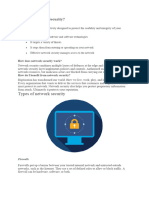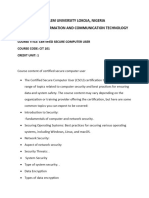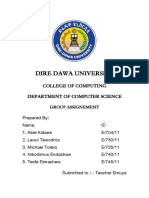Protecting Information Resources
Uploaded by
Rea RetodoProtecting Information Resources
Uploaded by
Rea RetodoChapter 5
Protecting Information Resources
Computer and network security has become critical for most organizations, especially in recent years with hackers, or computer criminals, becoming more numerous and adept at stealing and altering private information. Hackers use a variety of tools to break into computers and networks, such as sniffers, password crackers, and rootkits, and many others, which can be found free on the web. A comprehensive security system protects an organizations resources, including information and computer and network equipment. The type of information an organization needs to protect can take many forms: e-mails, in voices transferred via electronic data interchange (EDI), new products designs, marketing campaigns, and financial statements. A comprehensive security system includes hardware, software, procedures, and personnel that collectively protect information resources and keep intruders and hackers at bay. There are three important aspect of computer and network security: confidentiality, integrity, and availability, collectively referred to as the CIA TRIANGLE. Confidentiality means a system must not allow disclosing information to anyone who isnt authorized to access it. Integrity- ensures the accuracy of information resources in an organization. Availability ensures that computers and networks are operating, and authorized users can access the information they need. It should also ensure quickly recovery in case of system failure or disaster. TYPES OF HACKERS SCRIPT KIDDLE- an inexperienced, usually young hacker who uses programs others have developed to attack computer and network systems and deface Web sites. BLACK HAT- hackers who specialized in unauthorized penetration of information system. They attack system for profit, fun, or political motivations or as part of a social cause. These penetration attacks often involve modifying and destroying data. WHITE HAT (also known as ethical hacker)- computer security experts who specialize in penetration testing and other testing methods to ensure that a companys information systems are secure. When planning a comprehensive security system, the first step is designing fault-tolerant system, which have a combination of hardware and software for improving reliability-a way of ensuring availability in case of a system failure. Some commonly used methods includes the following: a. Uninterruptible power supply (UPS) b. Redundant array of independent disks (RAID) c. Mirror disk 2. SECURITY THREATS: AN OVERVIEW Threats can also be categorized by whether theyre unintentional (such as natural disasters, a users accidental deletion of data and structural failures) or intentional. Intentional threats include hacker attacks and attacks by disgruntled employees-spreading a virus on the
INTENTIONAL THREATS VIRUSES- consists of self propagating program code thats triggered by a specified time or event. WORM- also travels from a computer to computer in a network, but it doesnt usually erase data. Unlike viruses, worms are independent programs that can spread themselves without having to be attached to a host program. TROJAN PROGRAM- contains code intended to disrupt a computer, network, or Web site and is usually hidden inside a popular program. Users run the popular programs, unaware that the malicious program is also running in the background. LOGIC BOMB- is a type of trojan program used to release a virus, worm, or other destructive code. Logic bombs are triggered at a certain time or by an event, such as user pressing Enter or running a specific program. BACKDOOR- (trapdoor) is a programming routine built into a system by its designer or programmer. This routine enables the designer or programmer to bypass system security and sneak back into the system later to access programs or files. BLENDED THREATS- is a security threat that combines the characteristics of computer viruses, worms, and other malicious codes with vulnerabilities found on public and private networks. DENIAL-OF-SERVICE (DoS) ATTACK- floods a network or server with service requests to prevent legitimate users access to the system. SOCIAL ENGINEERING- means using people skills-such as being a good listener and assuming a friendly, unthreatening air-to trick others into revealing private information. This attack takes advantage of the human element of security systems. Security Measures and Enforcement: An Overview BIOMETRIC SECURITY MEASURES- use a physiological element to enhance security measures. These elements are unique to a person and cant be stolen, lost, copied, or passed on to others. The following list describes some biometric devices and measures : *facial recognition, fingerprints, hand geometry, iris analysis, palm prints, retinal scanning, signature analysis, vein analysis, and voice recognition MEASURES CALLBACK MODEMS- is used to verify whether a users access is valid by logging the user off (after he attempts to connects to the network) and then calling the user back at a predetermined number. FIREWALL- is a combination of hardware and software that acts as a filter or barrier between a private network and external computers or networks, including the internet. A network administrator defines rules for access, and all other data transmissions are blocked. INSTRUSION DETECTION SYSTEM (IDS)- can protect against both external and internal access. Theyre usually placed in front of a firewall and can identify attack signatures, trace
patterns, generates alarm for the network administrator, and cause routers to terminate connections with suspicious sources.
VENDORS Enterasys network inc. Cisco System, Inc. IBM Internet Security Systems Juniper Networks, Inc. Check Point Software Technologies, Ltd.
URL www.enterasys.com www.cisco.com www.iss.net www.juniper.net/us/en www.checkpoint.com
PHYSICAL SECURITY MEASURES- primary control access to computers and networks and include devices for securing computers and peripherals from theft. ACCESS CONTROL are designed to protect systems from authorized access to preserve data integrity. The following sections describe two used access controls: terminal resource security and passwords. TERMINAL RESOURCE SECURITY- is a software feature that erases the screen and signs the user off automatically after a specified length of inactivity. PASSWORDS- is a combination of numbers, characters, and symbols thats entered to allow access to a system. A passwords length and complexity determines its vulnerability to discovery by unauthorized users. VIRTUAL PRIVATE NETWORK- provides a secure tunnel through the internet for transmitting messages and data via a private network. DATA ENCRYPTION DATA ENCRYPTION- transforms data called plaintext or cleartext, into scrambled form called ciphertext that cant be read by others. SECURE SOCKETS LAYERS- is a commonly used encryption protocol that manages transmission security on the internet. TRANSPORT LAYER SECURITY- is a cryptographic protocol that ensures data security and integrity over public networks, such as the internet. ASSYMETRIC ENCRYPTION- uses two keys: a public key known to everyone and a private or secret key known to the recipient.
SYMMETRIC ENCRYPTION- also called secret key encryption the same key is used to encrypt and decrypt the message. The sender and receiver must agree on the key and keep it secret. In e-commerce transactions, three factors are critical for security: authentication, confirmation, and nonrepudiation. Authentication is important because using a credit card number in an online transaction doesnt mean the person using it is the cards legitimate owner. Confirmation- must also be incorporated into e-commerce transactions to verify orders and reciept of shipments. Nonrepudiation- is essential in case a dispute over a transaction is raised. Digital signatures are used for this factor and serve to bind partners in transaction. E-commerce transaction security is concerned with the following issues: CONFIDENTIALITY AUTHENTICATION INTEGRITY NONREPUDIATION OF ORIGIN NONREPUDIATION OF RECEIPT
University of the Assumption
Del Pilar San Fernando Pampanga
Written Report Protecting Information Resources
Submitted to: Ms. Maribeth Rivera Submitted by: Renea Maryll Alviz Angelie Nucum Mary Ann Garcia Angeli Carmel Yambao Jose Marie Ibe Allain Joseph Gonzales
You might also like
- CEH: Certified Ethical Hacker v11 : Exam Cram Notes - First Edition - 2021From EverandCEH: Certified Ethical Hacker v11 : Exam Cram Notes - First Edition - 2021No ratings yet
- Cybersecurity Internship Report Aicte: Computer Science Engineering (Kallam Haranadhareddy Institute of Technology)No ratings yetCybersecurity Internship Report Aicte: Computer Science Engineering (Kallam Haranadhareddy Institute of Technology)21 pages
- Security: Challenges/Threats To Is SecurityNo ratings yetSecurity: Challenges/Threats To Is Security16 pages
- Lecture2-InforSec-Computer and Internet SecurityNo ratings yetLecture2-InforSec-Computer and Internet Security20 pages
- Chapter 5. Cybersecurity and Risk Management TechnologyNo ratings yetChapter 5. Cybersecurity and Risk Management Technology30 pages
- Network Security - Attacks and Defense Mechanism by Designing An Intelligent Firewall AgentNo ratings yetNetwork Security - Attacks and Defense Mechanism by Designing An Intelligent Firewall Agent14 pages
- UNIT 5 Information Security Best Practices_20250214_084913_0000No ratings yetUNIT 5 Information Security Best Practices_20250214_084913_000011 pages
- Summary Chapter 8 Securing Informatin SystemNo ratings yetSummary Chapter 8 Securing Informatin System6 pages
- Security Technology - Firewall and VPN, Intrusion Detection System, Access ControlNo ratings yetSecurity Technology - Firewall and VPN, Intrusion Detection System, Access Control3 pages
- INFORMATION SECURITY AND CYBER LAWS 1st UNITNo ratings yetINFORMATION SECURITY AND CYBER LAWS 1st UNIT5 pages
- Cyber Security Interview Questions For Freshers: 1. What Is The Main Objective of Cyber Security?No ratings yetCyber Security Interview Questions For Freshers: 1. What Is The Main Objective of Cyber Security?24 pages
- Cybersecurity Analyst_ Top 30 Interview Q&ANo ratings yetCybersecurity Analyst_ Top 30 Interview Q&A8 pages
- Cyber Security: (Prof. Ashok K. Bhateja, IIT Delhi)No ratings yetCyber Security: (Prof. Ashok K. Bhateja, IIT Delhi)10 pages
- Dire Dawa University: College of Computing Department of Computer ScienceNo ratings yetDire Dawa University: College of Computing Department of Computer Science8 pages
- CYBER SECURITY HANDBOOK Part-1: Hacking the Hackers: Unraveling the World of CybersecurityFrom EverandCYBER SECURITY HANDBOOK Part-1: Hacking the Hackers: Unraveling the World of CybersecurityNo ratings yet
- Aws Reference Architecture Multi Region Cloudfront Api Gateway RaNo ratings yetAws Reference Architecture Multi Region Cloudfront Api Gateway Ra1 page
- Online Mobile Shopping: Mr. Sanjay Kumar YadavNo ratings yetOnline Mobile Shopping: Mr. Sanjay Kumar Yadav16 pages
- CH - 1 Relational Database Design UpdatedNo ratings yetCH - 1 Relational Database Design Updated80 pages
- CREATE EXTERNAL DATA SOURCE (Transact-SQL)No ratings yetCREATE EXTERNAL DATA SOURCE (Transact-SQL)15 pages
- Low Level Design LLD Document Template.docx (1)No ratings yetLow Level Design LLD Document Template.docx (1)6 pages
- 5.1 Secure Internal Communication SIC PDFNo ratings yet5.1 Secure Internal Communication SIC PDF12 pages
- Dbf510s - Database Fundamentals - 1st Opp - June 2022No ratings yetDbf510s - Database Fundamentals - 1st Opp - June 20229 pages
- Excel Lab 4 - Pivot Tables and Charts: Reference If NeededNo ratings yetExcel Lab 4 - Pivot Tables and Charts: Reference If Needed6 pages
- 1.gate Ies Psu Fluid Mechanics - Iesmaster-2021)100% (1)1.gate Ies Psu Fluid Mechanics - Iesmaster-2021)16 pages
- Defacto Veritas Certification PVT LTD - Company ProfileNo ratings yetDefacto Veritas Certification PVT LTD - Company Profile6 pages
- CEH: Certified Ethical Hacker v11 : Exam Cram Notes - First Edition - 2021From EverandCEH: Certified Ethical Hacker v11 : Exam Cram Notes - First Edition - 2021
- Cybersecurity Internship Report Aicte: Computer Science Engineering (Kallam Haranadhareddy Institute of Technology)Cybersecurity Internship Report Aicte: Computer Science Engineering (Kallam Haranadhareddy Institute of Technology)
- Chapter 5. Cybersecurity and Risk Management TechnologyChapter 5. Cybersecurity and Risk Management Technology
- Network Security - Attacks and Defense Mechanism by Designing An Intelligent Firewall AgentNetwork Security - Attacks and Defense Mechanism by Designing An Intelligent Firewall Agent
- UNIT 5 Information Security Best Practices_20250214_084913_0000UNIT 5 Information Security Best Practices_20250214_084913_0000
- Security Technology - Firewall and VPN, Intrusion Detection System, Access ControlSecurity Technology - Firewall and VPN, Intrusion Detection System, Access Control
- Cyber Security Interview Questions For Freshers: 1. What Is The Main Objective of Cyber Security?Cyber Security Interview Questions For Freshers: 1. What Is The Main Objective of Cyber Security?
- Cyber Security: (Prof. Ashok K. Bhateja, IIT Delhi)Cyber Security: (Prof. Ashok K. Bhateja, IIT Delhi)
- Dire Dawa University: College of Computing Department of Computer ScienceDire Dawa University: College of Computing Department of Computer Science
- CYBER SECURITY HANDBOOK Part-1: Hacking the Hackers: Unraveling the World of CybersecurityFrom EverandCYBER SECURITY HANDBOOK Part-1: Hacking the Hackers: Unraveling the World of Cybersecurity
- Aws Reference Architecture Multi Region Cloudfront Api Gateway RaAws Reference Architecture Multi Region Cloudfront Api Gateway Ra
- Dbf510s - Database Fundamentals - 1st Opp - June 2022Dbf510s - Database Fundamentals - 1st Opp - June 2022
- Excel Lab 4 - Pivot Tables and Charts: Reference If NeededExcel Lab 4 - Pivot Tables and Charts: Reference If Needed
- Defacto Veritas Certification PVT LTD - Company ProfileDefacto Veritas Certification PVT LTD - Company Profile

























































































